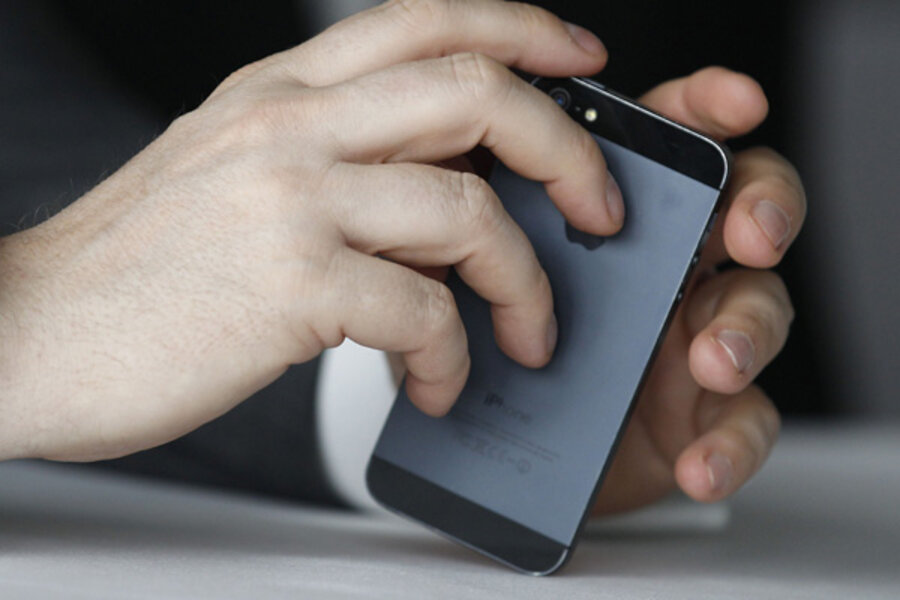Military invests in smart-phone reconnaissance
Loading...
Imagine a smart phone that can record your facial features, identify a criminal suspect with voice recognition, and reduce fraud in welfare and other programs.
In a few years, Smart Mobile Identity technology (SMI) may become an essential part of our daily lives, transforming everything from phone reception and online banking to identity verification of criminal suspects and enemies in combat.
The Department of Defense is looking to take advantage of biometrics developments with smart phones and similar devices. AOptix, a biometrics and identity technology firm, has received a $3 million contract from the Defense Department to help develop smart phones with SMI capabilities. Its team will collaborate with CACI International, a data security company.
Chuck Yort, vice president and general manager of Identity Solutions at AOptix, says in an email interview that the SMI technology will be available as a smart phone attachment that wraps around the phone (much like a case). The attachment would include iris and fingerprint sensors.
The SMI device will include an app for the user interface and identification features, among other functions, Mr. Yort says.
Similar technology is used for the identity verification of immigrants at airports and border crossings.
AOptix is one of several firms developing biometrics – biological analysis for data collection.
Data collection in the military
AOptix aims to make biometrics easy to use, Yort says. So between its versatility and clean user interface, the smart phone makes sense as the next medium.
As of now, the smart phone platform has iris scanning that works at a distance and in bright sunlight.
For the Defense Department, the smart-phone platform would mean being able to verify suspects and persons of interest in a war zone and collecting data more efficiently.
These kinds of developments are nothing new for the Defense Department, Wired’s Spencer Ackerman writes. The US Central Command still have data on three million people from the Iraq War, and the Defense Advanced Research Project Agency (DARPA) is working on devices that scan irises and fingertips from farther distances than SMI devices.
“It’s worth noting that even though the military is backing away from foot patrols in warzones, it’s not backing away from biometric data acquisition – far from it,” Mr. Ackerman writes.
However, faster, portable biometrics would work to the advantage of troops, who often have to act fast in high-pressure environments, Mark Crego, managing director of border and identity services at Accenture Health and Public Services, says in a phone interview.
The military’s data collection efforts could help keep troops safe in war zones and, as a result, make it easier for troops to trust inhabitants in those areas and build relationships with them, Mr. Crego says. If a base scanned the faces or fingerprints of locals (assuming they are open to it), the military would have an easier time weeding out potential suspects and getting to know the people.
“If I am setting up a military base and I cannot trust the people around me … the military base will never be able to integrate with the culture and help out the people around them,” he says. “We will have the ability to identify people and can build a better, trusting relationship between the community and the military.”
Biometrics at your fingertips
SMI technology is being marketed to a variety of other fields, including immigration, banking, health care, and disaster response.
Crego says biometrics can help reduce identity fraud and illegal immigration at many airports and border crossings. In India, the human services officials began scanning fingerprints to keep track of who participates in the food stamps program, in hopes of reducing fake claims.
For the individual, it could make a smart phone a better medium for data storage and banking.
“Biometrics by themselves are not a privacy problem anymore than using your name to get to your bank account,” he says. “The credit bureaus have more information than you’d want anyone to know … Using biometrics systems makes it much more difficult [for someone] to steal my identity.”
The only factor that could inhibit widespread use is the cost, Crego says. Developers have discussed price ranges in biometrics labs, but the specs remain expensive. Chances are, whenever an SMI smart phone hits stores, it will come with a high price tag.







